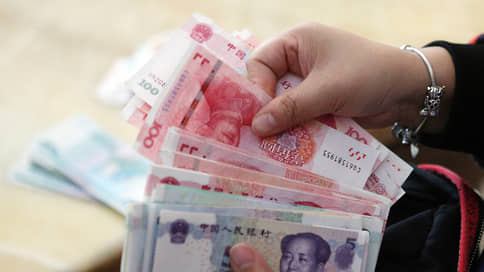Even with the yuan roll – Newspaper Kommersant No. 66 (7511) of 04/15/2023
[ad_1]

Russian banks experienced a significant shortage of yuan for the second time in April. This week, as part of the currency swap instrument, banks borrowed over CNY 3 billion from the Central Bank, with a limit of CNY 10 billion. According to experts, a currency swap with the Central Bank is the last resort for banks to attract yuan, because the rates for it are higher than on the exchange market.
Russian banks purchased a record amount of yuan from the Central Bank through currency swap operations – 3.1 billion CNY (37.3 billion rubles). The rate for foreign currency was 3.83% per annum, for rubles – 6.5% per annum. Immediately after the launch of this tool at the beginning of this year (see Kommersant on January 18), credit institutions rarely used this tool – a total of six sessions were held, with the first held only on March 24. At the same time, the volumes grew steadily, and the previous record was set ten days ago – on April 4, banks entered into swap transactions for 2.8 billion CNY (31.9 billion rubles). However, so far the demand for swap transactions with the Central Bank in Chinese currency is significantly less than the limit set by the regulator (10 billion CNY).
At the same time, at the end of the week, record volumes of swap transactions with Chinese currency were also recorded on the exchange market. In particular, on Thursday at the auctions of the Moscow Exchange the volume amounted to 398.7 billion rubles, and on Friday – 374 billion rubles. At the same time, since the beginning of the year, daily volumes did not exceed 300 billion rubles, and in most cases were below 250 billion rubles. The results of recent days more than double the total volume of trades in swaps with the dollar and the euro. Interest in rollovers in yuan has been exceeding the combined results in dollars and euros for several months, but earlier this year the excess was rarely more than 20%.
Analysts at Alfa-Bank noted that “the growth in demand for the yuan reflects the growth of trade with China.” At the same time, according to them, the growth in the use of the yuan does not mean that the supply of this currency is sufficient – the main way to create liquidity in the yuan within the Russian market was a trade surplus with China. However, by February of this year, it had fallen below $1 billion (whereas it peaked at $6 billion in May 2022). Combined with the ongoing withdrawal from dollars as the currency of yuan settlements, “this is the main reason why the Russian market may lack liquidity in yuan,” analysts say.
The growth in the volume of exchange swaps and other conversion transactions with the yuan reflects the general trend of the transition from “toxic” dollars and euros to “friendly” currencies: market participants regulate emerging currency positions and liquidity, says banking expert Alexei Nechaev.
However, according to him, “currency swap with the Central Bank for most of them remains as a fallback option.” Over the past weeks, the rates for attracting Chinese currency from the Central Bank were on average 1.5 percentage points higher than it can be done on the stock exchange, explains Mr. Nechaev. The volumes of recent transactions with the Central Bank may indicate that, most likely, we are talking about units of large banks (1-5), which occasionally need to attract additional yuan, says Evgeny Nadorshin, chief economist at PF Capital. “They go to the Central Bank if they couldn’t attract anywhere else,” Alexey Nechaev points out.
At the same time, the demand for yuan can be determined by regulatory or transactional needs. According to Mr. Nadorshin, in the first case, the yuan may be needed to manage an open foreign exchange position. “We see news about clients exiting the currency, which may force someone to adjust their currency position,” the expert explains. In the second case, it is possible that banks need foreign currency for some foreign trade operations with counterparties making payments with Chinese currency. Chinese banks do not interact very actively with Russian counterparties, so there cannot be many such players in the financial sector, Mr. Nadorshin points out.
[ad_2]
Source link





